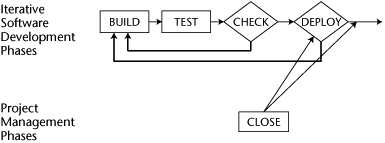The Closing Phase of the Iterative SDPM Strategy
Figure 22-1 illustrates the Closing Phase of the Iterative SDPM strategy. Note that there are really two parts to the Closing Phase just as there were in the Incremental SDPM strategy:
Closure with respect to each of the iterations
Closure with respect to the completed project
Figure 22-1. The Closing Phase of the Iterative SDPM strategy

Of course, there are some similarities between the Closing Phases of an Iterative SDPM strategy and Incremental SDPM strategy, but you find some key differences as well.
The similarities center on requirements satisfaction at the completion of each iteration. In the Incremental SDPM strategy, these closings were pretty much routine because all requirements had been clearly and completed defined and documented up front. That is not so in the Iterative SDPM strategy. Here many of the iterations have integrated new/revised functions and/or features, and their acceptance is not at all assured. Some iterations may close with some functions and/or features excluded from the acceptance only to be reworked in a later iteration. In other words the Closing Phase of an Iterative SDPM strategy contains some unknowns as compared to the Closing Phase of an Incremental SDPM strategy, which has largely been identified much earlier in the project.
When compared, the next iteration in both strategies shows similar ...
Get Effective Software Project Management now with the O’Reilly learning platform.
O’Reilly members experience books, live events, courses curated by job role, and more from O’Reilly and nearly 200 top publishers.

